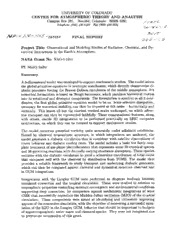
Observational and Modeling Studies of Radiative, Chemical, and Dynamical Interactions in the Earth''s Atmosphere PDF
Preview Observational and Modeling Studies of Radiative, Chemical, and Dynamical Interactions in the Earth''s Atmosphere
UNIVERSITY OF COLORADO CENTER FOR ATMOSPHERIC THEORY AND ANALYSIS Campus Box 391, Boulder, Colorado 80309-0391 Telephone (303) 492-6487 Fax (303) 492-S524 : "J 'Z'- ¢-:,o7o s7 FINAL REPORT Project Title: Observational and Modeling Studies of Radiative, Chemical, and Dy- namical Interactions in the Earth's Atmosphere. NASA Grant No: NAG-l-1355 PI: Murry Salby Summary A 3-dimensional model was developed to support mechanistic studies. The model solves the global primitive equations in isentropic coordinates, which directly characterize di- abatic processes forcing the Brewer-Dobson circulation of the middle atmosphere. It's numerical formulation is based on Hough harmonics, which partition horizontal motion into its rotational and divergent components. The formulation is spectral in all 3 coor- dinates, the first global primitive equation model to be so. Scale-selective dissipation, necessary for numerical stability, can then be imposed at 6th order - horizontally and vertically. This leaves all but the shortest vertical scales undamped, on which advec- tive transport can then be represented faithfully. These computational features, along with others, enable 3D integrations to be performed practically on RISC computer architecture, on which they can be iterated to support mechanistic studies. The model conserves potential vorticity quite accurately under adiabatic conditions. Forced by observed tropospheric structure, in which integrations are anchored, the model generates adiabatic circulation that is consistent with satellite observations of tracer behavior and diabatic cooling rates. The model includes a basic but fairly com- plete treatment of gas-phase photochemistry that represents some 20 chemical species and 50 governing reactions with diurnally-varying shortwave absorption. These species combine with the diabatic circulation to yield a wintertime distribution of total ozone that compares well with the observed by distribution from TOMS. The model thus provides a reliable framework to study transport and underlying diabatic processes, which can then be compared against chemical and dynamical structure observed and in GCM integrations. Integrations with the Langley GCM were performed to diagnose feedback between simulated convection and the tropical circulation. These were studied in relation to tropospheric properties controlling moisture convergence and environmental conditions supporting deep convection, for comparison against mechanistic integrations of wave CISK that successfully reproduce the Madden-Julian oscillation (MJO) of the tropical circulation. These comparisons were aimed at identifying and ultimately improving aspects of the convective simulation, with the objective of recovering a successful simu- lation of the MJO in the Langley GCM, behavior that should be important to budgets of upper-tropospheric water vapor and chemical species. They were not completed due to premature termination of this grant. Page2 Publications Salby, M., R. Garcia, and H. Hendon, 1994: Planetary-scale circulations in the presence of climatological and wave-induced heating. J. Atmos. Sci., 51, 2344-2367. Callaghan, P., A. Fusco, G. Francis, and M. Salby, 1998: A Hough spectral model for 3-dimensional studies of the middle atmosphere. J. Atmos. Sci. (Submitted). Fusco, A. and M. Salby, 1998: Forcing of chemical distributions in the stratosphere by planetary waves. J. Geophys. Res. (To be submitted).
